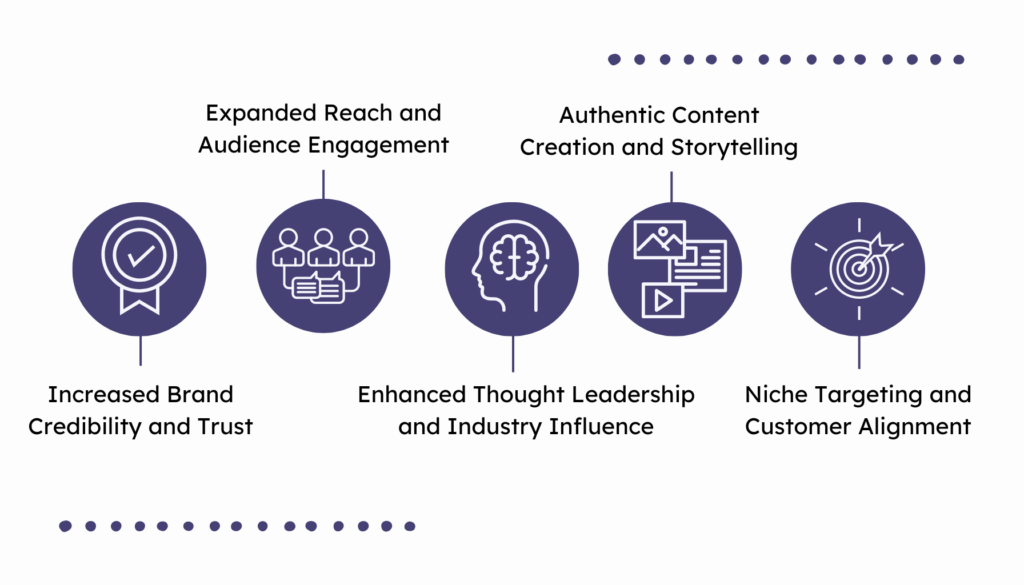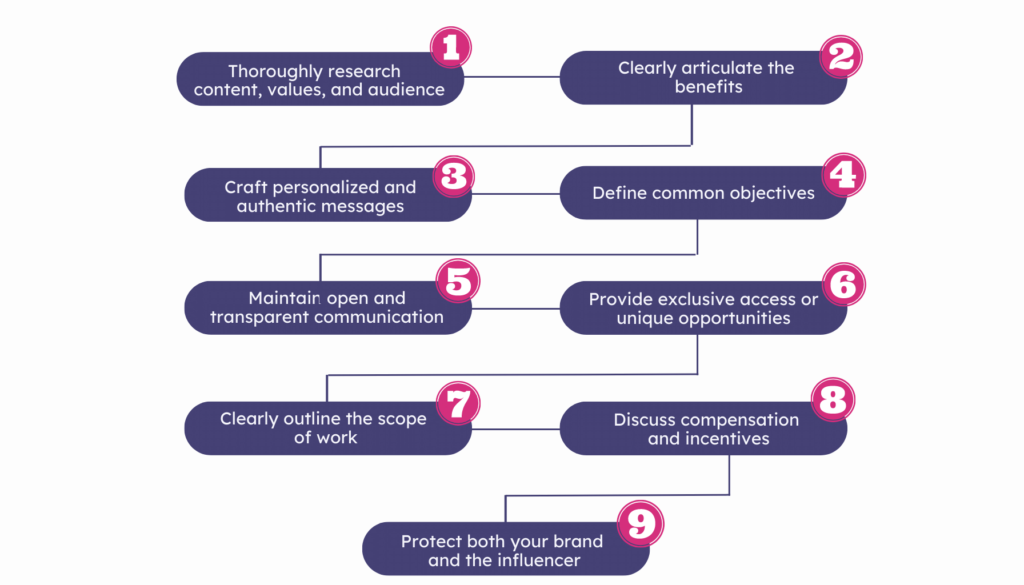
Influencer marketing has emerged as a powerful tool for customer acquisition, brand awareness, and credibility. While it has already gained significant traction in the B2C realm, many B2B companies remain hesitant or convinced it’s not suitable for their marketing strategies. However, influencer marketing holds immense potential for B2B brands to connect with their target audience, establish thought leadership, and drive meaningful business outcomes.
We’ll delve into the process of choosing the right influencers for your B2B marketing strategy. We’ll address common concerns, debunk myths, and provide you with practical insights and actionable steps to leverage influencer marketing effectively.
The Impact of Influencer Partnerships on B2B Brands
Influencer partnerships can have a significant impact on B2B brands with various benefits and outcomes. Here are some key ways influencer partnerships can positively impact B2B brands:
- Increased Brand Credibility and Trust: Partnering with influencers who have established expertise and authority in your industry can significantly boost your brand’s credibility. Their endorsement and recommendations can enhance trust among your target audience, leading to increased brand loyalty and customer confidence.
- Expanded Reach and Audience Engagement: Influencers have their own loyal and engaged audience, which can provide B2B brands with access to new segments and markets. Collaborating with influencers allows you to tap into their reach and connect with a wider audience, generating increased brand visibility, website traffic, and social media engagement.
- Enhanced Thought Leadership and Industry Influence: Working with influencers who are recognized thought leaders in your industry can elevate your brand’s status as an authoritative voice. Their expertise and insights can contribute to establishing your brand as a trusted source of industry knowledge, attracting customers who value expertise and thought leadership.
- Authentic Content Creation and Storytelling: Influencers excel at creating authentic and relatable content that resonates with their audience. By partnering with them, B2B brands can benefit from their creativity, storytelling skills, and ability to produce engaging content. This collaboration can help you connect with your target audience on a deeper level and foster a sense of authenticity and reliability.
- Niche Targeting and Customer Alignment: Influencers often have a niche or specific target audience that aligns with B2B brands’ target market. Partnering with influencers allows you to reach and engage with these specific segments, ensuring that your message reaches the right people who are more likely to be interested in your products or services.

Identify Your Target Audience and Preferences
Understanding your target audience is pivotal in selecting the right influencers. Take the time to conduct thorough research to gain insights into demographics, interests, pain points, and preferred channels of engagement. By doing so, you can identify influencers who have a genuine connection with your target audience and can effectively communicate your message.
Consider leveraging tools like social media analytics and market research reports to gain a deeper understanding of your audience. This data will help you refine your influencer search and ensure that the influencers you choose resonate with your target audience’s preferences and needs.
Define Your Specific Marketing Objectives for Your Influencer Strategy
Before diving into influencer selection, it is crucial to clearly define your specific marketing objectives. What do you aim to achieve with your influencer marketing strategy? Are you focused on increasing brand awareness, generating leads, driving conversions, or establishing thought leadership?
By outlining your goals, you can align your influencer marketing efforts accordingly and measure the success of your campaigns.
For example, if your objective is to enhance brand awareness, you may seek influencers with a wide reach and a knack for creating engaging content. On the other hand, if your goal is to drive conversions, you might prioritize influencers who are adept at crafting persuasive product demonstrations or reviews.
Tools and Platforms for Identifying and Vetting Influencers
Several tools and platforms have emerged to streamline the process of identifying and vetting influencers for your B2B marketing strategy. Here are some widely used solutions that can assist you in finding the right influencers:
- Social Media Analytics Tools: Tools like Sprout Social, Hootsuite, and Brandwatch allow you to track and analyze social media data. These platforms provide insights into influencer metrics such as follower count, engagement rate, and audience demographics. By using these tools, you can easily identify influencers who align with your target audience and industry.
- Influencer Marketing Platforms: Platforms like Upfluence, Traackr, and Grin provide databases of influencers across various industries. These platforms offer search filters based on niche, location, reach, and engagement. You can use these filters to narrow down your search and find influencers who are relevant to your B2B marketing goals.
- Social Listening Tools: Tools like Mention, Brand24, and Talkwalker enable you to monitor social media conversations and mentions related to your industry. With these tools, you can identify influencers who are actively engaged in discussions and have a significant impact on your target audience. Social listening tools also help you uncover emerging influencers who may not have gained widespread recognition yet.
- Content Discovery Platforms: Platforms such as BuzzSumo and Feedly allow you to discover influential content creators and thought leaders in your industry. These platforms curate popular and trending content, making it easier for you to identify influencers with a strong content presence. You can analyze the engagement and social sharing of their content to assess their influence and audience reach.
- LinkedIn Search and Groups: LinkedIn, being a professional networking platform, is particularly useful for B2B influencer research. Leverage the advanced search function to find influencers based on specific criteria such as industry, job title, location, and company size. Join LinkedIn groups relevant to your industry to identify active contributors and thought leaders who can potentially be your influencers.
- Google Alerts: Setting up Google Alerts for industry-related keywords and topics can help you identify influencers who frequently produce content in your niche. You will receive email notifications whenever new content is published, enabling you to discover influential individuals and assess their content quality and relevance.
- Engage in Industry Events and Conferences: Attend industry events and conferences where influential professionals gather. Pay attention to speakers, panelists, or workshop leaders who demonstrate expertise and have a strong following. These individuals can be potential influencers for your B2B marketing campaigns.

Align Influencer Selection with Your B2B Marketing Goals
Once you have a clear understanding of your marketing objectives and target audience, it’s crucial to assess the relevance of influencers to your specific industry and niche. Here are some things to consider:
- Content Alignment: Evaluate the influencer’s content to ensure it aligns with your industry and the topics you want to promote. Look for influencers who consistently produce high-quality content that resonates with your target audience.
- Niche Expertise: Consider influencers who possess in-depth knowledge and expertise in your niche, and who are recognized as thought leaders in their field. They should possess subject matter expertise and demonstrate authority through their content and engagement with their audience.
- Audience Overlap: Look for influencers whose audience overlaps with your target audience. Analyze the demographics and interests of the influencer’s followers to determine if they match your buyer personas.
- Reach and Engagement: Analyze the influencer’s reach and engagement metrics. While a large follower count is important, engagement is equally crucial. Look for influencers who consistently generate meaningful interactions with their audience through comments, shares, and likes.
Suppose you’re a B2B software company specializing in cloud computing services. After conducting research, you come across an influencer on LinkedIn who consistently publishes informative and well-researched articles on cloud technology. This influencer has a substantial following of IT professionals and decision-makers in the tech industry.
By reviewing their content, you find that their articles align perfectly with the topics your target audience is interested in. Additionally, their expertise is evident through the engagement they receive, with industry experts frequently engaging in discussions and seeking their insights.
Building Relationships with Influencers
Building strong relationships with influencers is vital for successful partnerships. Focus on the following aspects:
- Before reaching out, thoroughly research the influencer’s content, values, and audience to tailor your value proposition accordingly. Show that you genuinely appreciate their work and explain why their partnership is valuable for your brand.
- Clearly articulate the benefits of collaborating with your brand. Showcase how the partnership can help the influencer expand their reach, enhance their authority, or offer unique opportunities to engage with their audience. Emphasize the potential value their participation brings to both parties.
- Craft personalized and authentic messages that demonstrate your understanding of the influencer’s work. Avoid generic pitches and show that you have taken the time to learn about their expertise and interests. Personalization can significantly increase the chances of grabbing their attention and sparking their interest.
- Collaborate with influencers to define common objectives that align with both your brand’s marketing goals and the influencer’s audience and interests. This shared vision sets the foundation for a productive and long-term partnership.
- Maintain open and transparent communication with influencers throughout the collaboration. Regularly check-in, provide updates, and be responsive to their queries and suggestions. Actively involve them in the decision-making process and show that their input is valued.
- Provide influencers with exclusive access or unique opportunities related to your brand. This can include early access to new products, invitations to industry events, or the chance to collaborate on special projects. By offering something special, you strengthen the partnership and demonstrate your commitment to their success.
- Clearly outline the scope of work, content format, and timeline for deliverables. Discuss the specific tasks the influencer will undertake, such as creating blog posts, social media campaigns, or attending events. Align expectations on the quality, tone, and style of content to ensure it aligns with your brand’s values.
- Discuss compensation and incentives with influencers based on their expertise, audience size, and the scope of the collaboration. Compensation can include monetary payment, free products or services, affiliate partnerships, or revenue-sharing models. Be open to negotiation and find a mutually beneficial arrangement.
- Protect both your brand and the influencer by drafting a clear and comprehensive contract that covers important legal aspects. Consult with legal professionals to ensure compliance with relevant regulations and intellectual property rights. Clearly define ownership of content, confidentiality clauses, and termination conditions.

Measuring Success and ROI: How to Analyze Performance Metrics
Once your influencer campaigns are live, it’s crucial to track and analyze performance metrics to assess their effectiveness.
Pro tip: remember that the KPIs to measure will depend on the marketing objectives set at the very beginning of the campaign. It’s tempting to measure, for instance, all the followers acquired, but if you’re aiming for conversions, that should be your North Start.
Here are key performance metrics to consider:
- Reach and Impressions: Measure the total number of people exposed to your influencer’s content. This includes metrics like follower count, views, or impressions.
- Engagement Metrics: Analyze the level of audience engagement generated by the influencer’s content. This includes metrics such as likes, comments, shares, retweets, and mentions.
- Website Traffic: Use tracking tools like Google Analytics or referral software to monitor the amount of traffic driven to your website from the influencer’s content. Track metrics like clicks, unique visitors, and page views.
- Conversion Rates: Determine the percentage of website visitors or leads that convert into customers. Measure metrics such as click-through rates, lead submissions, and sales attributed to the influencer campaign.
- Cost Per Acquisition (CPA) or Return On Ad Spend (ROAS): Calculate the cost required to acquire a customer or the revenue generated per dollar spent on the influencer campaign. These metrics provide insights into the campaign’s cost-effectiveness and overall ROI.
Based on the analysis of performance metrics, it’s important to iterate and optimize your influencer partnerships to enhance results. To do that, you should:
- Identify Top-Performing Influencers: Analyze the performance metrics of different influencers and identify those who consistently deliver strong results. Consider forming long-term partnerships with these influencers to leverage their success.
- Experiment and Diversify: Test different types of content, collaborations, or messaging with your influencers to identify what resonates best with your target audience. Continuously experiment and iterate based on the insights gained from the campaign results.
- Communicate and Provide Feedback: Maintain open communication with your influencers throughout the campaign. Provide constructive feedback, share performance metrics, and collaborate on optimizing content to align with your goals.
- Optimize Campaign Elements: Based on the data and insights gathered, make data-driven adjustments to your influencer campaigns. This can include refining targeting, adjusting content formats, optimizing calls-to-action, or modifying campaign timelines.
- Measure and Compare Results: Regularly measure the performance of your influencer campaigns and compare them to previous campaigns or benchmarks. This allows you to track progress and identify trends.
Successful B2B Influencer Marketing Campaigns
Real-world examples of successful B2B influencer marketing campaigns can provide valuable insights and inspiration for your own strategies. Here are a few notable cases:
Microsoft and Neil Patel
Microsoft collaborated with renowned digital marketer Neil Patel to promote its cloud computing solutions. Neil Patel, known for his expertise in the digital marketing industry, created educational content and case studies highlighting the benefits of Microsoft’s cloud services. The campaign resulted in increased brand awareness, lead generation, and conversions for Microsoft. By leveraging Neil Patel’s authority and reach, Microsoft successfully positioned itself as a trusted provider of cloud solutions.
Salesforce and Gary Vaynerchuk
Salesforce partnered with entrepreneur and marketing expert Gary Vaynerchuk to drive brand awareness and engagement for its CRM software. Gary Vaynerchuk created engaging content, including videos and podcasts, where he discussed the importance of customer relationship management and highlighted Salesforce’s features and benefits. The campaign not only increased Salesforce’s visibility among its target audience but also generated positive sentiment and trust around the brand.
Adobe and LinkedIn influencers
Adobe collaborated with influential professionals on LinkedIn, such as industry leaders, executives, and experts, to promote its creative software solutions. These influencers shared their success stories, tips, and insights on how Adobe’s tools helped them achieve their professional goals. The campaign effectively reached a B2B audience and positioned Adobe as a go-to solution for creative professionals in various industries.
Understand your customer journey analytics
See how your users behave, find drop-offs, and receive actionable insights with AI.

Conclusion
Choosing the right influencers for your B2B marketing strategy can have a significant impact on your brand’s success. By conducting thorough research, assessing authority and credibility, using tools and platforms, and establishing strong partnerships, you can maximize the benefits of influencer marketing. Remember to set measurable KPIs, track performance metrics, and iterate based on results to ensure optimal ROI. By learning from successful case studies and understanding the impact of influencer partnerships, you can leverage the power of influencers to drive brand awareness, credibility, and engagement in the B2B space.








